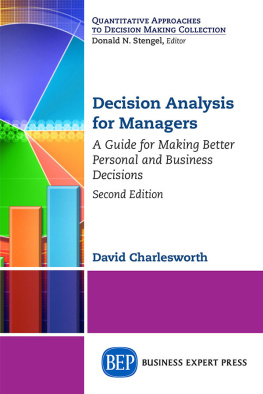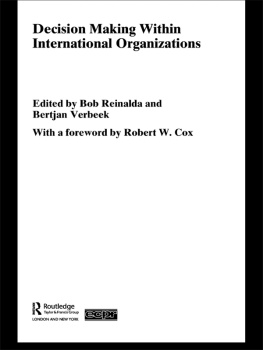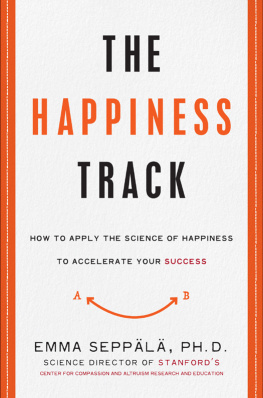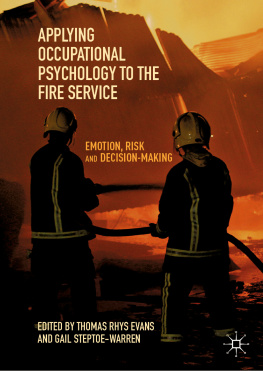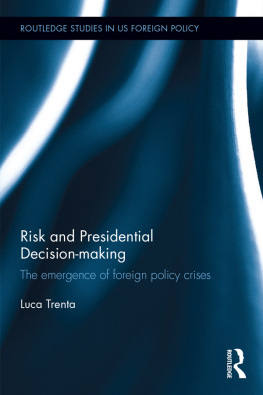Spurgin Anthony J. - Decision-making in high risk organizations under stress conditions
Here you can read online Spurgin Anthony J. - Decision-making in high risk organizations under stress conditions full text of the book (entire story) in english for free. Download pdf and epub, get meaning, cover and reviews about this ebook. year: 2016, publisher: Taylor & Francis Group, genre: Romance novel. Description of the work, (preface) as well as reviews are available. Best literature library LitArk.com created for fans of good reading and offers a wide selection of genres:
Romance novel
Science fiction
Adventure
Detective
Science
History
Home and family
Prose
Art
Politics
Computer
Non-fiction
Religion
Business
Children
Humor
Choose a favorite category and find really read worthwhile books. Enjoy immersion in the world of imagination, feel the emotions of the characters or learn something new for yourself, make an fascinating discovery.

- Book:Decision-making in high risk organizations under stress conditions
- Author:
- Publisher:Taylor & Francis Group
- Genre:
- Year:2016
- Rating:4 / 5
- Favourites:Add to favourites
- Your mark:
- 80
- 1
- 2
- 3
- 4
- 5
Decision-making in high risk organizations under stress conditions: summary, description and annotation
We offer to read an annotation, description, summary or preface (depends on what the author of the book "Decision-making in high risk organizations under stress conditions" wrote himself). If you haven't found the necessary information about the book — write in the comments, we will try to find it.
Decision-making in high risk organizations under stress conditions — read online for free the complete book (whole text) full work
Below is the text of the book, divided by pages. System saving the place of the last page read, allows you to conveniently read the book "Decision-making in high risk organizations under stress conditions" online for free, without having to search again every time where you left off. Put a bookmark, and you can go to the page where you finished reading at any time.
Font size:
Interval:
Bookmark:
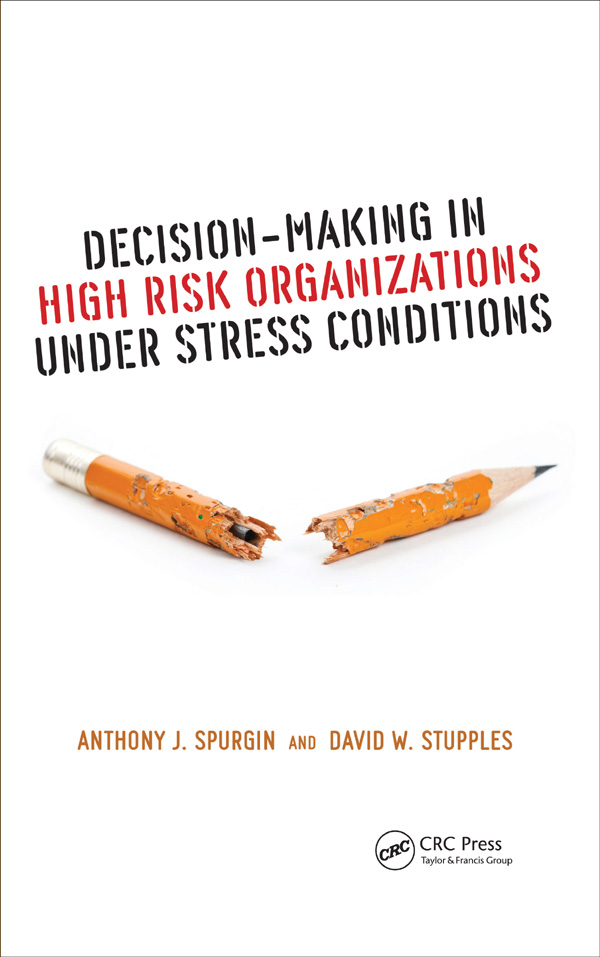
DECISION-MAKING IN
HIGH RISK ORGANIZATIONS
UNDER STRESS CONDITIONS
HIGH RISK ORGANIZATIONS
UNDER STRESS CONDITIONS
ANTHONY J. SPURGIN AND DAVID W. STUPPLES

CRC Press
Taylor & Francis Group
6000 Broken Sound Parkway NW, Suite 300
Boca Raton, FL 33487-2742
2017 by Taylor & Francis Group, LLC
CRC Press is an imprint of Taylor & Francis Group, an Informa business
No claim to original U.S. Government works
Printed on acid-free paper
Version Date: 20160317
International Standard Book Number-13: 978-1-4987-2122-6 (Hardback)
This book contains information obtained from authentic and highly regarded sources. Reasonable efforts have been made to publish reliable data and information, but the author and publisher cannot assume responsibility for the validity of all materials or the consequences of their use. The authors and publishers have attempted to trace the copyright holders of all material reproduced in this publication and apologize to copyright holders if permission to publish in this form has not been obtained. If any copyright material has not been acknowledged please write and let us know so we may rectify in any future reprint.
Except as permitted under U.S. Copyright Law, no part of this book may be reprinted, reproduced, transmitted, or utilized in any form by any electronic, mechanical, or other means, now known or hereafter invented, including photocopying, microfilming, and recording, or in any information storage or retrieval system, without written permission from the publishers.
For permission to photocopy or use material electronically from this work, please access www.copyright.com (http://www.copyright.com/) or contact the Copyright Clearance Center, Inc. (CCC), 222 Rosewood Drive, Danvers, MA 01923, 978-750-8400. CCC is a not-for-profit organization that provides licenses and registration for a variety of users. For organizations that have been granted a photocopy license by the CCC, a separate system of payment has been arranged.
Trademark Notice: Product or corporate names may be trademarks or registered trademarks, and are used only for identification and explanation without intent to infringe.
Library of Congress Cataloging-in-Publication Data
Names: Spurgin, Anthony J., author. | Stupples, David W., author.
Title: Decision-making in high risk organizations under stress conditions /
Anthony J. Spurgin and David W. Stupples.
Description: 1 Edition. | Boca Raton : Taylor & Francis Group, 2016. |
Includes bibliographical references and index.
Identifiers: LCCN 2016000967 | ISBN 9781498721226 (alk. paper)
Subjects: LCSH: Decision making. | Job stress. | Management.
Classification: LCC HD30.23 .S7217 2016 | DDC 658.4/03--dc23
LC record available at http://lccn.loc.gov/2016000967
Visit the Taylor & Francis Web site at
http://www.taylorandfrancis.com
and the CRC Press Web site at
http://www.crcpress.com
NO MAN IS AN ISLAND
No man is an island entire of itself; every man
is a piece of the continent, a part of the main;
if a clod be washed away by the sea, Europe
is the less, as well as if a promontory were, as
well as any manner of thy friends or of thine
own were; any mans death diminishes me,
because I am involved in mankind.
And therefore never send to know for whom
the bell tolls; it tolls for thee.
MEDITATION XVII
Devotions upon Emergent Occasions
John Donne 1573-1631
We have been interested in the occurrence of accidents and the relationships of organizational operations to the accidents. Potentially a lot more can be done to reduce the number and severity of accidents. In this, we have been confirmed in the study of ranges of accidents that have occurred in different industries and countries. Our studies in this field are reflected in this book.
The world is strongly affected by accidentsfrom local incidents to more global accidents that lead to the deaths of thousands of people and economic stresses in impacted countries The accidents range from a single death because of a traffic accident to a whole country affected by the arrival of a tsunami that destroys houses, kills hundreds of people, and floods the countryside with salt water that restricts the capability of the land to produce food for the population, possibly leading to hunger and malnourishment for years.
History tells us that every country is affected by accidents, and it appears that we cannot escape from being burdened by these events occurring and affecting us, individually, with pain and financial hardship.
We have been involved in the study of organizations and the impact of accidents on organizations. The idea of an accident being a random event over which we have no control and are in no way capable of preventing is an undesirable one. Closer examination of accidents reveals that if different decisions were made, better studies carried out, and the attitude of key persons were open to think more clearly about the likely consequence of actions, then the probability of an accident occurring could be heavily reduced.
The managers of more complex systems are required to be better prepared than for simple systems. From our background in the study of systems and related accidents, we have become more aware that the frequency of accidents in all kinds of situations can be reduced. It may not be totally possible to eliminate all accidents, because one lacks the ability to control everyone and everything. However, one can develop methods and techniques to enable persons directing and carrying out actions to minimize the potential for inadvertent decisions and actions being taken that lead to accidents.
This philosophy flies in the face of the normal approach to accidents (Perrow, 1999). Perrows model seems very much influenced by the Three Mile Island accident sequence. His point was that as people make mistakes, big accidents have small beginnings and failures are those of organizations. The main idea is that failures are built into societys complex and tightly coupled systems, and as such accidents are unavoidable and cannot be designed around. We believe that organizations can be helped to reduce the probability of accidents and we lay out the processes here to accomplish this.
Our reanalysis constructs a different view of an accident (see ). Our studies of a variety of accidents indicate that there are key events in most accident sequences where if the key decisions are approached differently, it would be very likely that the accident would not occur. In the field of accident analyses, there are parallel situations in which one decision path leads to failure and another path leads to success. This shows that it is not inevitable that a single failure will lead to an accident. The awareness of the decision-maker of an undesirable situation can be increased by being subject to better background training. This training should make a difference and lead to a reduced probability of a situation escalating to a damaging accident. It is better to avoid an accident than try to recover from the effects of an accident progression. The progression of an accident can tend to obscure the root causes of the accident and make it much more difficult for the organization to recover.
Font size:
Interval:
Bookmark:
Similar books «Decision-making in high risk organizations under stress conditions»
Look at similar books to Decision-making in high risk organizations under stress conditions. We have selected literature similar in name and meaning in the hope of providing readers with more options to find new, interesting, not yet read works.
Discussion, reviews of the book Decision-making in high risk organizations under stress conditions and just readers' own opinions. Leave your comments, write what you think about the work, its meaning or the main characters. Specify what exactly you liked and what you didn't like, and why you think so.


